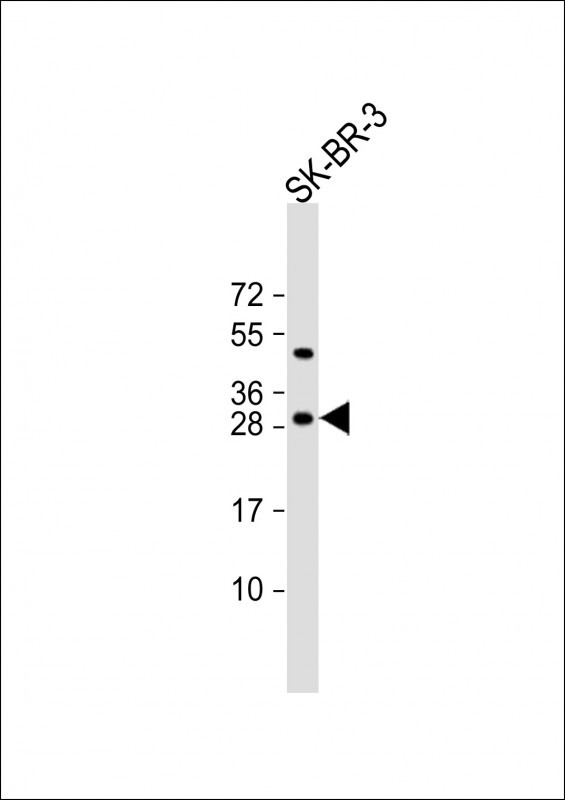
| WB | 1/1000 | Human,Mouse,Rat |
| IF | 咨询技术 | Human,Mouse,Rat |
| IHC | 咨询技术 | Human,Mouse,Rat |
| ICC | 技术咨询 | Human,Mouse,Rat |
| FCM | 咨询技术 | Human,Mouse,Rat |
| Elisa | 咨询技术 | Human,Mouse,Rat |
| Aliases | Beta-casein, CSN2, CASB |
| Entrez GeneID | 1447 |
| WB Predicted band size | 25.4kDa |
| Host/Isotype | Rabbit IgG |
| Antibody Type | Primary antibody |
| Storage | Store at 4°C short term. Aliquot and store at -20°C long term. Avoid freeze/thaw cycles. |
| Species Reactivity | Human |
| Immunogen | This CSN2 antibody is generated from rabbits immunized with a KLH conjugated synthetic peptide between 25-54 amino acids from the N-terminal region of human CSN2. |
| Formulation | Purified antibody in PBS with 0.05% sodium azide. |
+ +
以下是关于CSN2(N端)抗体的3篇参考文献,按研究领域和内容分类整理:
1. **文献名称**:*The COP9 signalosome: An assembly and maintenance platform for cullin ubiquitin ligases?*
**作者**:Seeger, M. et al.
**摘要**:该研究首次报道了COP9信号体复合体(包括CSN2亚基)的纯化与功能分析,描述了针对CSN2 N端区域的多克隆抗体的开发,并用于验证其在蛋白质复合体中的定位及与其他亚基的相互作用。
2. **文献名称**:*CSN2 deficiency promotes tumorigenesis through dysregulation of ribosomal protein-MDM2-p53 signaling*
**作者**:Wei, S. et al.
**摘要**:研究利用抗CSN2 N端抗体(Western blot和免疫组化)证明CSN2在多种癌症中表达下调,并揭示其通过调控核糖体蛋白-MDM2-p53通路抑制肿瘤发生的机制。
3. **文献名称**:*Arabidopsis CSN2 regulates photomorphogenesis through interaction with HY5*
**作者**:Schwechheimer, C. et al.
**摘要**:通过植物模型研究COP9信号体功能,使用CSN2 N端抗体进行免疫共沉淀实验,发现CSN2通过结合光形态发生关键因子HY5调控光信号转导通路。
---
**扩展提示**:
- **抗体应用场景**:上述抗体多用于蛋白质互作(Co-IP)、亚细胞定位(如核质分布分析)及表达量检测(如癌症vs正常组织对比)。
- **技术验证**:部分文献提及抗体特异性验证方法(如siRNA敲低后信号消失,或重组蛋白抗原阻断实验)。
- **跨物种适用性**:Schwechheimer研究中抗体可能在拟南芥和人类细胞间存在交叉反应,需注意物种特异性声明。
如需进一步分析特定研究方向的文献或抗体实验方案优化,可提供更多背景信息。
**Background of CSN2 (N-term) Antibody**
The CSN2 (COP9 signalosome subunit 2) antibody targets the N-terminal region of the CSN2 protein, a critical component of the COP9 signalosome complex. This evolutionarily conserved, multi-protein complex plays a central role in regulating ubiquitin-proteasome-mediated protein degradation by modulating the activity of cullin-RING E3 ubiquitin ligases (CRLs). CSN2. also known as SGN2 or Trip15. is essential for maintaining the structural integrity of the COP9 complex and its enzymatic functions, particularly in catalyzing the removal of NEDD8 (deneddylation) from cullins. This process is vital for CRL activity cycling, impacting diverse cellular processes such as cell cycle progression, DNA damage response, and signal transduction.
CSN2 (N-term) antibodies are widely used in research to study CSN2 expression, localization, and interactions via techniques like Western blotting, immunofluorescence, and immunoprecipitation. Dysregulation of CSN2 has been linked to pathological conditions, including cancer, developmental disorders, and immune diseases, making it a potential therapeutic target. Antibodies specific to the N-terminal region help dissect post-translational modifications, protein stability, and complex assembly, offering insights into COP9's role in cellular homeostasis. Their application also extends to analyzing tissue-specific expression patterns and validating CSN2 knockout or knockdown models in experimental studies.
×